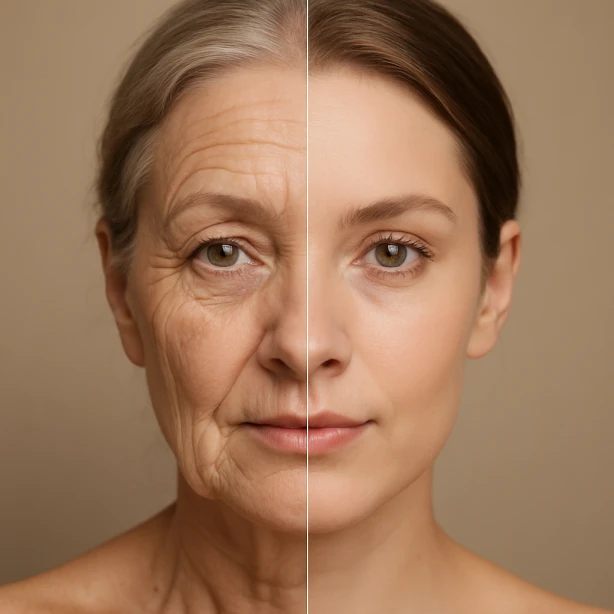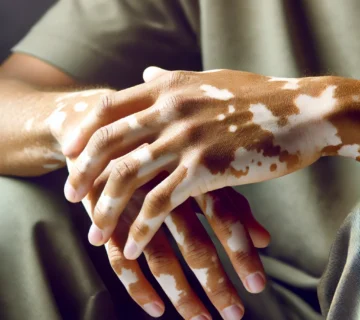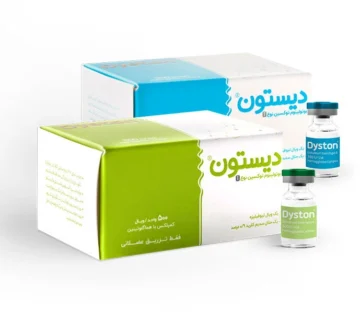Causes and Treatments of Skin Wrinkles
Skin wrinkles are among the most prominent signs of skin aging, typically appearing with age, especially after the third decade of life. However, multiple factors—both intrinsic and extrinsic—contribute to their formation. Indeed, medical interventions in skin rejuvenation primarily aim to reduce or eliminate these wrinkles. A thorough understanding of the underlying causes can help in the prevention, treatment, or mitigation of wrinkles. These causes include:
Intrinsic Aging
The aging process is a natural biological phenomenon that gradually alters the structure of the skin:
-
Reduced collagen and elastin production: These two proteins are essential for skin firmness, elasticity, and youthfulness. With age, their synthesis slows down.
-
Loss of subcutaneous fat: The fatty layers that give skin fullness gradually diminish, leading to sagging and wrinkle formation. One medical intervention is the injection of fillers to restore lost volume and rejuvenate the skin.
-
Decreased cell turnover: New skin cells replace old ones at a slower rate.
-
Skin dryness: Reduced sebum secretion leads to drier skin, which predisposes to wrinkle formation.
Extrinsic Aging
1. Sun Exposure (Photoaging)
Ultraviolet (UV) radiation, particularly UV-A and UV-B, plays a major role in degrading collagen and elastin fibers.
-
This damage causes skin laxity, loss of elasticity, and wrinkle formation.
-
Sunlight also contributes to age spots and uneven skin texture.
2. Air Pollution
-
Airborne particles, smoke, and heavy metals generate free radicals that damage skin tissue.
-
Chronic inflammation leads to premature skin aging.
3. Smoking and Tobacco Use
-
Smoking constricts blood vessels, reducing oxygen supply to the skin.
-
Nicotine disrupts collagen synthesis.
-
Repetitive lip movements during smoking accelerate perioral wrinkle formation.
Dynamic Wrinkles
Repetitive facial expressions—such as frowning, smiling, or squinting—result in dynamic wrinkles. Initially visible only during muscle activity, these lines eventually become permanent.
Dehydration and Poor Nutrition
-
Inadequate water intake leads to dry skin and reduced cell volume.
-
Deficiency in antioxidants, vitamins (especially A, C, E), and essential fatty acids (such as omega-3) accelerates aging.
-
High-sugar diets stiffen collagen fibers, worsening wrinkles.
Stress and Sleep Deprivation
-
Chronic stress elevates cortisol, damaging skin tissues and promoting inflammation. Avoiding stress is a key principle in rejuvenation.
-
Poor sleep disrupts nightly skin cell repair, aggravating dullness and wrinkles.
Genetics
-
Skin type (dry, oily, thin) and familial aging patterns significantly influence wrinkle development.
-
Fair-skinned individuals are more prone to photoaging and early wrinkle formation.
Hormonal Changes
-
In women, decreased estrogen during menopause results in skin thinning, dryness, and sagging.
-
This is a major factor in post-40 skin aging.
Prevention and Treatment of Wrinkles
Although aging is inevitable, adopting proper skincare, healthy nutrition, sun protection, and topical treatments can slow the aging process and preserve healthier, younger-looking skin. Evidence-based strategies include:
Sun Protection
-
Sunscreens: Daily use of sunscreen with SPF ≥ 30, even on cloudy days or indoors, prevents collagen breakdown and wrinkle formation.
-
Physical protection: Hats, sunglasses, and protective clothing provide additional defense against direct UV exposure.
Topical Skincare Treatments
Key active ingredients include:
-
Retinoids (e.g., Retinol): Stimulate collagen synthesis, improve skin texture, and reduce fine lines.
-
Peptides (e.g., Matrixyl, Argireline): Promote collagen and elastin production; gentler than retinoids for sensitive skin.
-
Hyaluronic Acid: Provides deep hydration and plumps fine lines.
-
Vitamin C (Ascorbic Acid): A potent antioxidant that brightens, stimulates collagen, and protects against UV damage.
-
Niacinamide (Vitamin B3): Reduces inflammation, improves skin elasticity, and diminishes fine lines.
-
Alpha Hydroxy Acids (AHAs): Exfoliate dead skin cells and stimulate renewal.
-
Antioxidants (e.g., Vitamin E, Resveratrol, Coenzyme Q10): Counteract free radical damage.
-
Botanical stem cells: Encourage skin regeneration.
-
Essential fatty acids and natural extracts (e.g., rosehip oil, green tea): Provide antioxidant and soothing benefits.
Recommended routine:
-
Gentle cleansing with sulfate-free cleansers
-
Morning antioxidant serums (e.g., Vitamin C)
-
Moisturizer suitable for skin type
-
Daily sunscreen
-
Night application of retinol or peptide-based serums
Nutrition and Anti-Aging Supplements
-
Beneficial foods: Colorful fruits/vegetables (antioxidants), fatty fish (omega-3), nuts, seeds, and sufficient water.
-
Supplements: Hydrolyzed collagen, Vitamins C/E, zinc, biotin, omega-3 fatty acids.
Healthy Lifestyle
-
Adequate sleep: Nighttime is critical for cellular repair; sleep deprivation accelerates wrinkles.
-
Stress management: Practices such as meditation, yoga, and deep breathing reduce cortisol-related skin damage.
-
Avoiding smoking and alcohol: Smoking depletes collagen and reduces circulation; alcohol dehydrates skin and accelerates wrinkles.
Professional and Medical Treatments
-
Non-invasive methods:
-
Microneedling: Stimulates collagen renewal.
-
Mesotherapy: Injects vitamins and nutrients into the skin.
-
Fractional laser therapy: Resurfaces deeper layers.
-
High-Intensity Focused Ultrasound (HIFU): Non-surgical lifting.
-
-
Invasive methods:
-
Botox injections: Relax dynamic wrinkles by reducing muscle activity.
-
Dermal fillers: Restore lost volume and smooth deep lines.
-
Thread lifting or surgical facelift: Advanced options for severe wrinkles.
-
Natural and Home Remedies (with caution)
-
Oils such as argan, rosehip, or aloe vera nourish and soften the skin.
-
Gentle massage with oils or tools (e.g., gua sha, jade roller) enhances circulation.
-
While not substitutes for clinical treatments, these remedies serve as supportive measures.
Peptides and Wrinkle Treatment
Peptides are short chains of amino acids that act as biological messengers, stimulating or modulating processes within skin cells. Depending on their type, peptides may boost collagen/elastin synthesis, inhibit enzymes that degrade skin proteins, or provide anti-inflammatory benefits. Today, they are among the most promising anti-aging agents.
Key Peptides
-
Signal Peptides: Stimulate structural proteins such as collagen and elastin.
-
Matrixyl (Palmitoyl Pentapeptide-4): Well-studied; enhances collagen and hyaluronic acid synthesis. Regular use reduces fine wrinkles and firms the skin.
-
Matrixyl 3000: A combination of Palmitoyl Tripeptide-1 and Palmitoyl Tetrapeptide-7. More potent; stimulates collagen, reduces inflammation, and prevents protein degradation.
-
-
Neurotransmitter-Inhibiting Peptides: Function like “topical Botox” by reducing muscle contractions responsible for dynamic wrinkles.
-
Argireline (Acetyl Hexapeptide-8): Known as “Botox in a bottle.” Studies show up to 30% wrinkle depth reduction with consistent use.
-
Syn-Ake: Mimics snake venom protein, reducing facial lines from repetitive movements.
-
-
Carrier Peptides: Deliver trace minerals such as copper to the skin.
-
Copper Peptides (GHK-Cu): Promote collagen synthesis, wound healing, and skin regeneration while reducing inflammation.
-
-
Anti-inflammatory and Antioxidant Peptides:
-
Palmitoyl Tripeptide-5 (Syn-Coll): Stimulates TGF-β production, enhancing collagen synthesis and rejuvenation while offering antioxidant protection.
-
Usage Guidelines:
-
Best combined in stable serums/creams with appropriate pH.
-
Consistent use for 4–12 weeks yields visible results.
-
Avoid combining with destabilizing compounds (e.g., acidic Vitamin C, strong retinoids) unless formulated accordingly.
Peptides, particularly Matrixyl and Argireline, represent intelligent biological solutions in combating aging signs. Their proper selection, combined with long-term use and healthy lifestyle habits, provides significant rejuvenation potential.
A Scientific Innovation: AtraZist Aray Peptide Serum
For those seeking a scientifically validated product for wrinkle treatment, AtraZist Aray Peptide Serum offers an ideal solution. Formulated with two of the most effective peptides in the cosmetic industry—Argireline (Acetyl Hexapeptide-8) and Matrixyl (Palmitoyl Pentapeptide-4)—this serum simultaneously reduces superficial muscle contractions (Botox-like effect) and stimulates collagen and elastin production.
Key Features:
-
Scientifically formulated blend of advanced peptides with proven efficacy
-
Significant reduction of both dynamic and static wrinkles
-
Improved skin firmness and resilience within weeks of consistent use
-
Suitable for all skin types, including sensitive skin
Developed with precision in AtraZist Aray’s Research and Development unit, this serum not only rejuvenates but also ensures a safe and enjoyable skincare experience.
AtraZist Aray Peptide Serum—where science meets beauty—marks an effective step toward youthful, radiant skin.






بدون دیدگاه